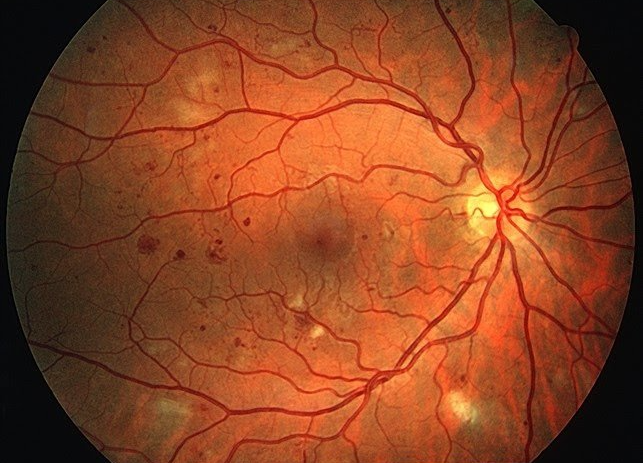Diabetic Retinopathy
What is Diabetic Retinopathy?
Diabetic retinopathy is a disorder that harms the blood vessels within the retina. Affecting patients between the ages of 18 – 65 with Type 1 or Type 2 diabetes, diabetic retinopathy is the leading cause of vision impairment and blindness. Uncontrollable sugar levels can make the retinal blood vessels swell, leak, or become blocked, which can lead to permanent damage and in some cases, blindness. This serious disease may become worse over time and in the earlier stages, symptoms are not always detectable.
If you have Type 1 or Type 2 diabetes, it’s extremely important to attend yearly eye exams so our team of skilled, ophthalmologists at Visionary Eye Surgeons can check your ocular health and determine if you have diabetic retinopathy. If you have diabetes, especially if you find it difficult to control your sugar levels, we highly recommend scheduling an appointment so that we can collaborate with our endocrinology colleages.
Get in touch
Diabetic Retinopathy Form
We will get back to you as soon as possible.
Please try again later.
Generally, at first, patients do not exhibit any noticeable signs during the first part of the disease. However, as the condition worsens, you may start to experience uncomfortable symptoms. If left untreated this may lead to retinal tears or detachments and difficult to treat glaucoma that cannot be easily repaired. Some of the primary indications of damage caused by diabetic retinopathy include:
- Immediate changes in vision
- Developing floaters
- Fuzzy or distorted vision
- Loss in the ability to identify colors
- Reduced vision acuity
- Pain or pressure in the eye
Diabetic retinopathy happens in Type 1 and Type 2 men and women who have a medical history of severe spikes in their blood sugar levels. If you have been diagnosed with diabetes, it’s extremely important to properly monitor and control your blood sugar levels and pursue professional medical care. When your sugar is too high, retinal blood vessels start to harden, expand, and create blockages, which can cause bleeding or leakage if not correctly managed. If left undiagnosed and untreated, diabetic retinopathy may produce macular edema (macular swelling) or macular ischemia (blood has difficulty reaching the macula).
What is Diabetic Macular Edema?
Diabetic macular edema (DME) is a condition that is directly caused by diabetic retinopathy, which leads to swelling in that part of the retina known as the macula. The macula is essential for the central vision field and is used for reading, recognition, and driving.
Generally, at first, patients do not exhibit any noticeable signs during the first part of the disease. However, as the condition worsens, you may start to experience uncomfortable symptoms. If left untreated this may lead to retinal tears or detachments and difficult to treat glaucoma that cannot be easily repaired. Some of the primary indications of damage caused by diabetic retinopathy include:
- Immediate changes in vision
- Developing floaters
- Fuzzy or distorted vision
- Loss in the ability to identify colors
- Reduced vision acuity
- Pain or pressure in the eye
Diabetic retinopathy happens in men and women with Type 1 and Type 2 diabetes who have poor blood glucose control and have had the disease for a number of years. In addition, diabetics that have a medical history of severe spikes in their blood sugar levels can develop diabetic retinapathy. If you have been diagnosed with diabetes, it’s extremely important to properly monitor and control your blood sugar levels and pursue professional medical care. When your sugar is too high, retinal blood vessels start to harden, expand, and create blockages, which can cause bleeding or leakage if not correctly managed. If left undiagnosed and untreated, diabetic retinopathy may produce macular edema (macular swelling) or macular ischemia (blood has difficulty reaching the macula).
What is Diabetic Macular Edema?
Diabetic macular edema (DME) is a condition that is directly caused by diabetic retinopathy, which leads to swelling in that part of the retina known as the macula. The macula is essential for the central vision field and is used for reading, recognition, and driving.
Treatment Options
Our ophthalmologists at Visionary Eye Surgeons are excited to provide a variety of innovative treatments for diabetic retinopathy, which we can tailor based on the severity of your disease. For patients with a more severe cases, patients may need anti-VEGF (vascular endothelial growth factor), which stops the growth of irregular blood vessels and can reduce DME.
Early detection and the management of diabetes are essential to preventing harmful symptoms and restoring your eye health. However, if not treated, the negative side effects may become permanent, including vision loss. To reduce or stop the progression of diabetic retinopathy, it’s imperative to regulate your sugar and attend yearly eye exams.
Call
Office: 780-424-2233
Fax: 780-426-7219
All Rights Reserved | Visionary Eye Surgeons | Website Created by CCC
